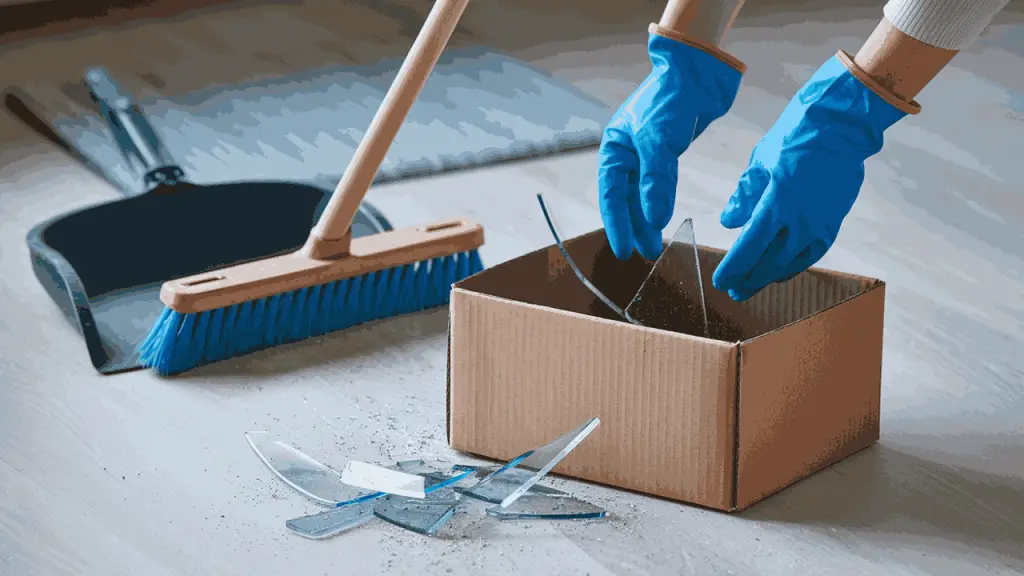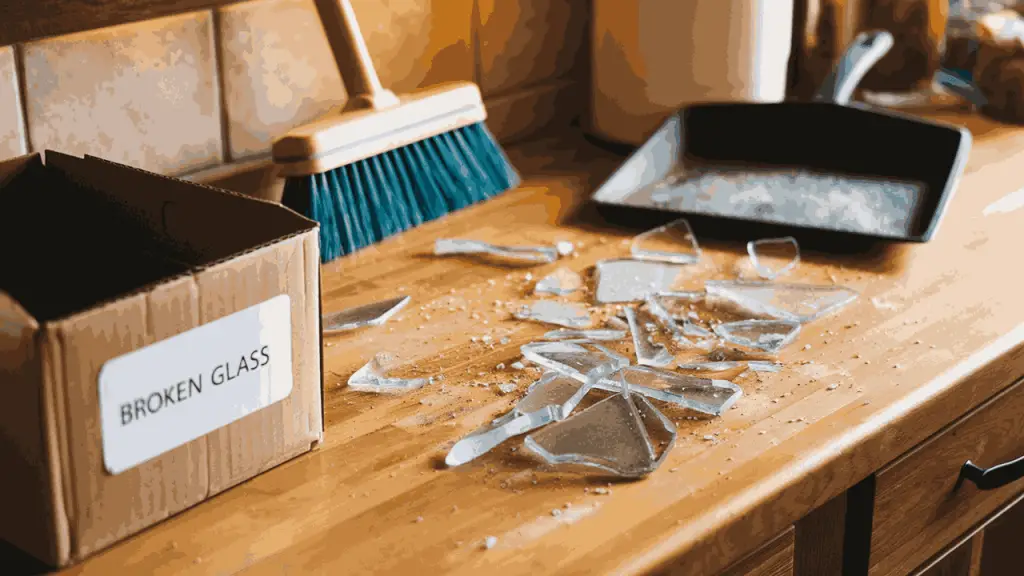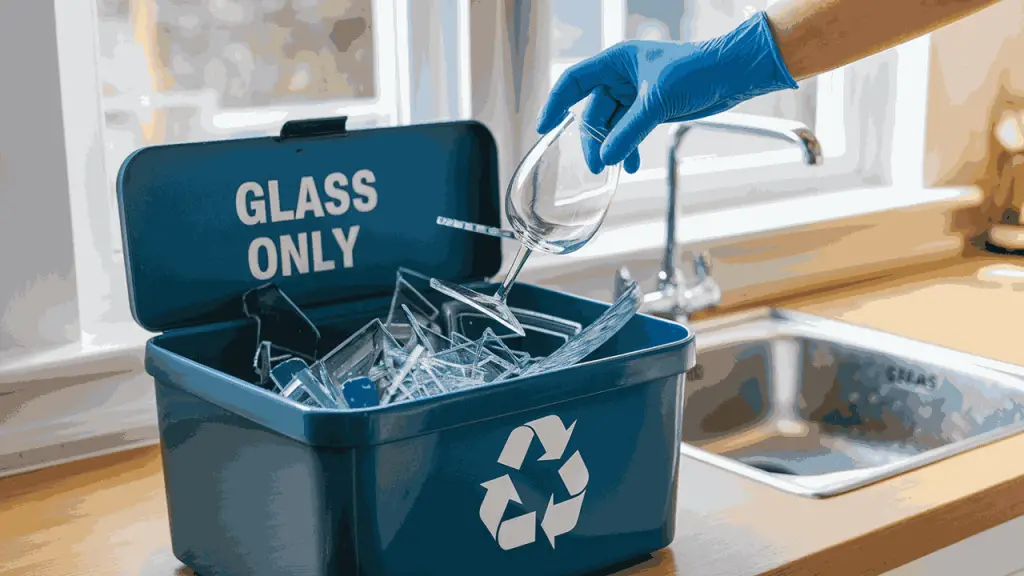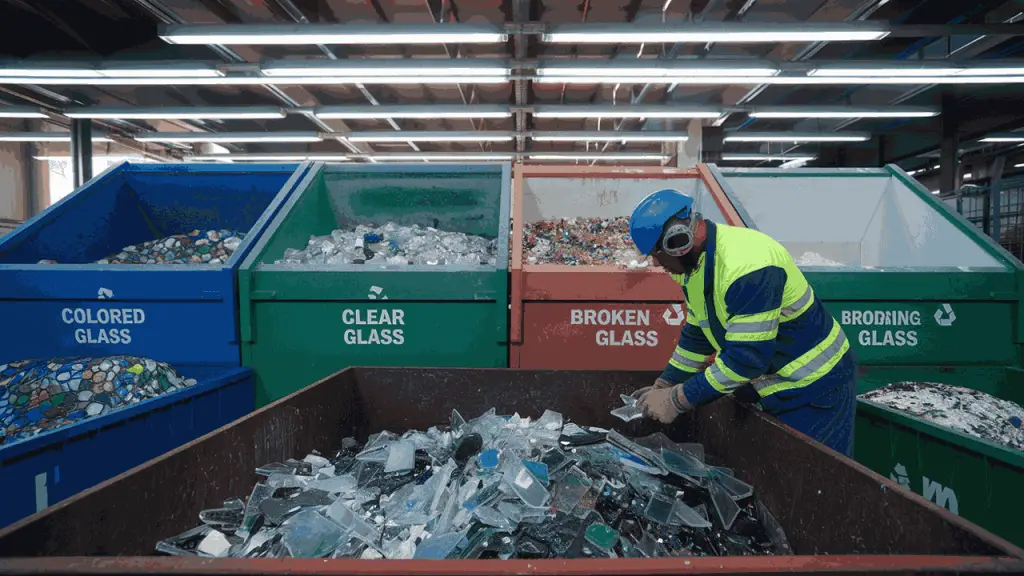Broken glass isn’t just inconvenient, it can be dangerous. Disposing of it properly helps prevent injuries and keeps recyclables free from contamination.
This guide explains how to clean up safely, dispose of glass correctly, and consider recycling options. Whether it’s shattered glass or a broken window, you’ll find the best ways to handle it responsibly. Stay safe and clean up smartly.

Safety Precautions for Handling Broken Glass
A. Wear protective gear (gloves, eye protection, closed-toe shoes)
When handling broken glass, your safety is paramount. Always wear appropriate personal protective equipment (PPE) to minimize risks. Don protective gloves, preferably cut-resistant ones, to protect your hands from cuts and lacerations.
Shield your eyes with safety goggles to prevent flying shards from causing injury. Ensure you’re wearing closed-toe shoes to safeguard your feet from potential hazards.
B. Prepare a sturdy container for disposal
| Container Type | Advantages |
| Sharps Container | Specifically designed for glass disposal |
| Sturdy Cardboard Box | Easily available and disposable |
| Rigid Plastic Bin | Reusable and durable |
Before cleanup, prepare a sturdy container for safe disposal. Use a designated sharps container, a sturdy cardboard box, or a rigid plastic bin. This precaution prevents further accidents during disposal.
With these safety measures in place, you’re ready to move on to the step-by-step broken glass cleanup process.
Step-by-Step Broken Glass Cleanup

Remember to keep your protective gear on throughout this process to ensure your safety.
A. Collect large glass pieces
Start by carefully picking up the largest pieces of broken glass. Use gloves or kitchen tongs to protect your hands.
Place these larger shards into a sturdy container or wrap them in multiple layers of newspaper for safe disposal later.
B. Locate and gather smaller shards
To effectively find and collect smaller glass fragments:
- Use bright lighting, such as an LED flashlight, to spot reflective shards.
- Sweep the area with a stiff-bristled broom, being careful not to scatter pieces.
- For tiny shards, try these innovative methods:
- Press a halved raw potato onto the surface
- Use a soft slice of bread to attract glass pieces
- Employ thick packing or duct tape
- Dab with a folded, damp paper towel
| Method | Effectiveness | Best for |
| Potato | High | Hard surfaces |
| Bread | Medium | Textured surfaces |
| Tape | High | Small areas |
| Damp towel | Medium | Large areas |
C. Wrap glass in a towel for added safety
Once you’ve collected all visible glass pieces, wrap them securely in a towel or thick layers of newspaper. This extra layer of protection prevents sharp edges from poking through during disposal.
D. Clean area with damp cloths and vacuum
For a thorough final cleanup:
- Use dampened paper towels to wipe down the area, capturing any remaining tiny shards.
- Vacuum the area carefully, paying special attention to carpets and rugs.
- Check your shoes and the soles of anyone who was in the vicinity to prevent tracking glass elsewhere.
Remember to rinse your cleaning tools outside to remove any lingering glass fragments.
Proper Disposal Methods
Now that we’ve covered the step-by-step process of cleaning up broken glass, let’s move on into the proper disposal methods to ensure safety for everyone involved.
A. Secure glass in a sealed, labeled box
To dispose of broken glass safely, you’ll need to secure it in a sealed, labeled box. Here’s how:
- Put on protective gear: thick work gloves, eye protection, and closed-toe shoes.
- Prepare a sturdy cardboard box lined with a trash bag.
- Wrap the collected glass shards in a towel for an extra layer of safety.
- Place the wrapped glass bundle in the prepared box.
- Seal the box securely with packing tape.
- Label the box clearly with warnings about the broken glass content.
B. Dispose as regular trash (check local guidelines)
Once you’ve secured the broken glass, you can dispose of it as regular trash. However, it’s crucial to:
- Check your local guidelines for any specific disposal instructions.
- Never discard broken glass into open trash containers.
- Avoid placing glass in garbage disposals, as this can lead to damage and injury.
C. Consider professional help for large quantities
While small amounts of broken glass are manageable, larger quantities may require professional assistance:
| Situation | Recommended Action |
| Shattered windows | Seek professional help |
| Glass embedded in furniture | Contact a specialist |
| Multiple broken items | Consider junk removal service |
The average cost for junk removal services is around $250, which can be a worthwhile investment for ensuring the safe disposal of large amounts of broken glass.
D. Avoid placing in garbage disposals
It’s vital to remember that glass should never be placed in garbage disposals. If glass accidentally gets stuck in your disposal:
- Turn off the power to the unit.
- Use appropriate tools to safely remove the glass.
- Dispose of the removed glass following the methods outlined above.
With these proper disposal methods in mind, next, we’ll explore recycling considerations for broken glass, as recycling options may vary depending on the type and condition of the glass.
Recycling Considerations

While glass is 100% recyclable, there are some limitations you should be aware of.
A. Limitations on recycling broken glass
- Small shards may be rejected due to difficulty in verifying composition
- Window glass and container glass shouldn’t be mixed
- Broken crystal, tempered glass, and non-bottle glass aren’t recyclable
B. Check with local facilities for acceptance
You should always verify with your local recycling facilities before disposing of broken glass. Some may accept it, while others might not due to safety concerns.
C. Separate intact glass for potential recycling
| Glass Type | Recyclability |
| Bottles and jars | Recyclable |
| Drink glasses | Not recyclable |
| Pyrex | Not recyclable |
Curious about other glass? Learn more with How to Recycle Glass Jars and Bottles at Home or tackle big stuff with How To Dispose Of Large Mirrors!Additional Disposal Options

Now that we’ve covered recycling considerations, let’s explore additional disposal options for broken glass.
A. Junk removal services for larger quantities
For substantial amounts of broken glass, such as from shattered windows or glass-embedded furniture, consider hiring a junk removal service like 1-800-GOT-JUNK, Waste Mission, or Reconomy.
B. Proper handling of glass with hazardous materials
| Material | Handling Method |
| Toxic substances | Use protective gear |
| Chemical residues | Seek professional help |
C. Avoid placing glass in open dumpsters
You should never discard broken glass in open trash containers or dumpsters. This practice can lead to injuries for waste handlers and others who come into contact with the waste. Always use secure, labeled containers for glass disposal.
Community Resources and Guidelines
Local waste management services
You can contact your local waste management services for guidance on proper disposal methods.
Many municipalities offer special collection days for hazardous materials, including broken glass. Check their websites or call their helplines for information on schedules and accepted items.
| Service | Description |
| Special collection days | Designated times for hazardous material disposal |
| Helplines | Direct contact for disposal guidance |
| Online resources | Websites with schedules and accepted items |
Conclusion
Properly disposing of broken glass keeps you, your community, and waste workers safe. Always wear protective gear, use sturdy containers, and clean up thoroughly to prevent injuries. Whether it’s a small mess at home or a bigger cleanup, handling glass the right way is essential.

